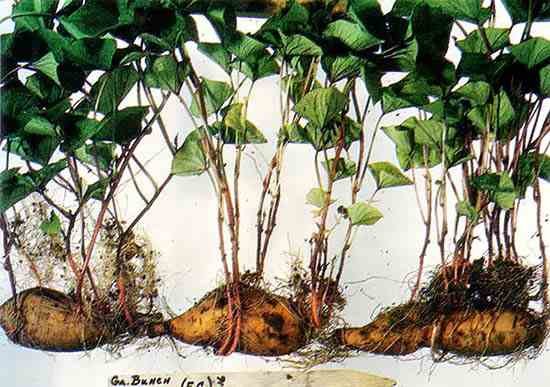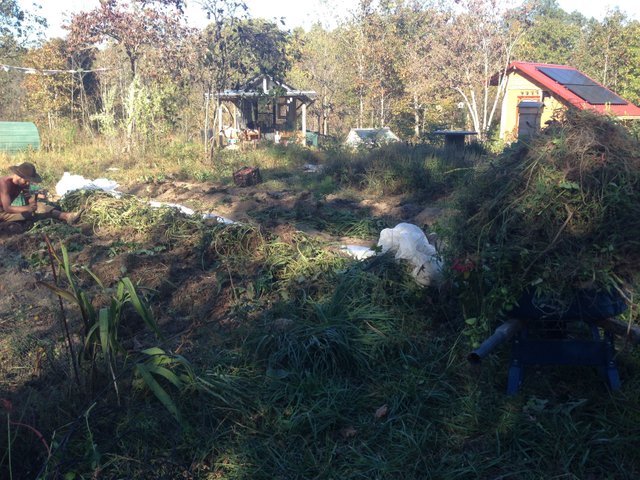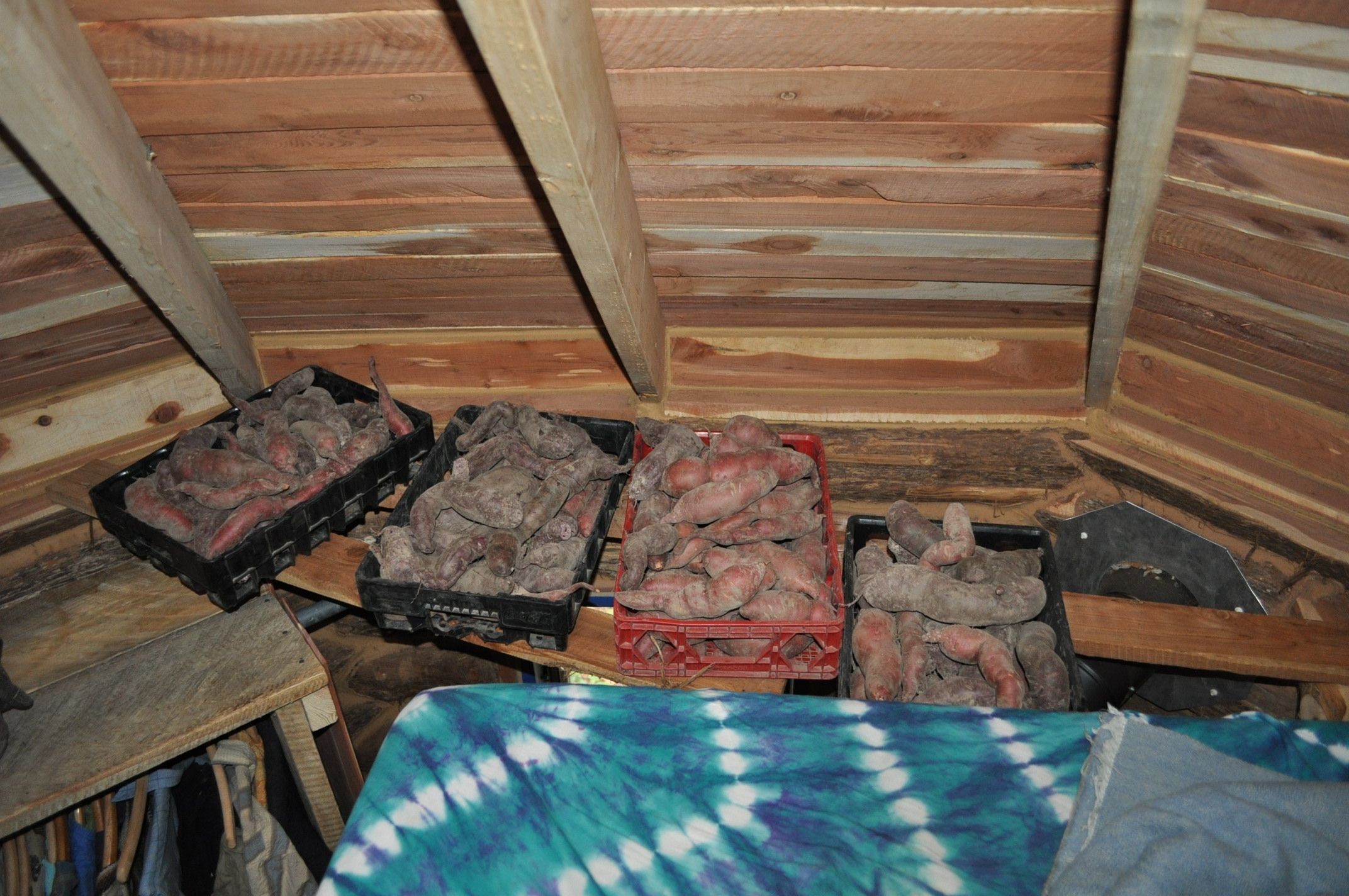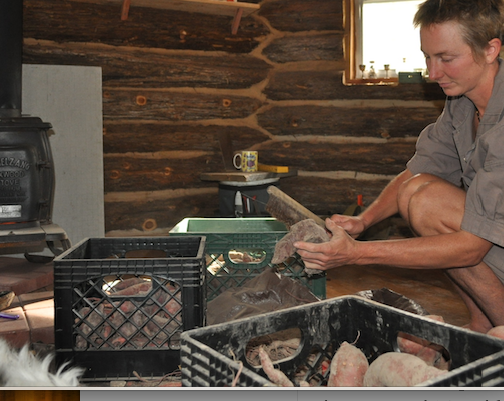Staple Crops | How To Grow & Cure Sweet Potatoes
It's time for our epic sweet potato post! Through synchronicity @cahlen reminded us it was time to post it. With great passion and adoration, here it is!

Staple crops are of vital important to the subsistence homesteader, as they can provide the bulk of the calories.
Beyond calories we also have to consider the ease of growing and processing, the delicious factor and of course the nutritional components beyond fats, protein and carbs (like antioxidant vitamins A and C). Since moving to the south, we have had great success with growing sweet potatoes as a staple crop. This article will take you through our foray into growing sweet potatoes and show you how you can grow delicious boss sweet potatoes at home (or in a community garden, or guerrilla style wherever you can put something into the earth).

(A bumble bee on a sweet potato flower)
We had a little exposure growing sweet potatoes, but when our close friends raved about how easy they are to grow and store, we were all in!

Sweet potatoes are only second compared to winter squash for easily produced storage crops. The favor is slowly shifting though. After our first season growing an abundance of storable tubers with little effort, no irrigation and a bonus of edible leaves we were sold. We did irrigate the following year and noted an increase in yields.
The plant vines out and sprawls profusely, developing tubers where it is rooted. They provide a great ground cover, don't need a lot of attention and have fragrant flowers that bees frequent. One reality is that they are very frost sensitive and require 90-170 days to reach full maturity, although we have gotten great yields in less than 120. If you live in an area with a shorter growing season, seek out varieties suited to your locale.

Prepping the beds

Our first year on the land we had a lot to do, but a major priority was getting some earth prepped for planting. So dig we did. Using our trusty mattock, we removed buckets and buckets of rocks, chipping away at the never ending supply. We created raised beds about 24" wide with a 12" path by double digging and piling the soil from the path onto the bed. We added some horse manure and leaf mulch to augment the organic matter sorely lacking in our soil. We didn't add much nitrogen as this would lead to lush foliage and smaller tuber development. Sweet potatoes are not fussy and will yield even in poor soil. Before planting sweet potatoes in these beds, we had a crop of garlic the previous year. It's always good to rotate crops.
Preparing the slips

(source)
Sweet potatoes are grown from shoots known as slips that emerge from last year's tubers. This is one the reasons we love growing this crop. You can get numerous slips from a sizable tuber and they in turn produce numerous tubers. Seeing the pattern of abundance here?
If you grew some last year and they have kept well, they should start growing shoot slips on their own. To encourage this you can place the tips of tubers in a jar of water, providing extra moisture that signals the coming growing season. Once the shoots emerge, place them in an area with access to light. Once they reach 6" or so they are almost ready to fly the coop and go off in to the great wide world. They should be clipped or pinched off from the tuber, but make sure to remove the butt end as this area may harbor disease. Place slips in a small amount of water (changing every so often) until fine white roots appear. The process is pretty fool proof!
If you are growing sweet potatoes for the first time, you'll have to buy or barter for slips. They are usually 25-50 cents a piece. When you're successful, there will be plenty of slips for you and friends for next year.
Planting

(A pic to give an idea of spacing and rows. When we did irrigate last summer, we sometimes just flooded the rows in a passive style of irrigation.)
Style and spacing differs between growers, but we grow ours in raised beds spaced 3 feet between row and a foot apart within the row. We pick an everning or overcast day to plant in order to make the transition from water to soil a wee bit gentler. Begin by removing all but the top few leaves. Poke a hole deep enough to insert the entire slip. This will encourage the majority of the slip to grow roots, while leaving a few leaves to feed the growing roots. We water in the slips after each row with a dilute kelp solution to provide trace minerals and ease transplanting shock. Don't be shy- a heavy soaking will settle the soil around the slip and ensure constant moisture during this crucial phase.
Mulching

This is a very important step as it will keep your plants happier (not to mention the soil microbes will sing and dance) with less effort from you. We use wheat straw and lay it on about 4" deep. Leaves or grass clipping will work too. The important thing is to cover the soil. Nature abhors a vacuum and we want to fill the space between the vines with mulch not other opportunistic plants. Mulch will suppress weed growth while retaining moisture in the soil. The mulch will break down and become food for microbes and insects.
Here is a pic of our seldom watered sweet potatoes. You can see them reaching up for the sun and tightening their leaves together. Despite our experimentation with low watering frequency, we got great yields. Mulching to help retain moisture is a big part of this!

Training
The vines may look sad for the first few days, but if you keep the soil moist they should perk up in no time. Once they establish themselves they explore in vigorous growth. They are in the same family as bindweed and morning glory and if you've ever seen these species grow, you can appreciate how profuse sweet potato growth can be.

The vines will root readily if kept in contact with soil. Many such rooting areas will lead to more numerous but smaller tubers. We gently place the vines growing in the path back into the bed every so often. Even so, we did get more small tubers than was ideal. These don't tend to store as well and make moving, washing and prepping more tedious.
Throughout the season, we eat the greens regularly and the vines don't seem to reduce in vigor. People eat sweet potato greens all over the world! We don't strip the plants, but we ate them almost daily and even put up quite a few blanched bags of leaves in the freezer. The texture and taste is similar to spinach, although even milder. Definitely worth growing even if you don't get a tuber yield.
One method we will experiment with this year is trellising the vines. This will ensure that each plant only has one rooting area and should make for larger tubers. It will also make for easier picking of the greens and perhaps can act as a shade zone if we put a bench under the trellised vines.
Harvesting

This is by far the most rewarding part of the season (except perhaps eating them baked in a cast iron on a wood stove months after harvest = pure satisfaction!!). After watching the vines grow and grow and grow, you get to go hunting for subterranean treasure. We keep an eye on the weather and when frost is approaching we make ready to harvest. A very light frost will damage the leaves, but even a mild frost may damage tubers and reduce their storability.

For this task we use a garden fork or hari hari (Japanese garden multitool) for this task. Gently lifting the soil, the tubers reveal themselves in all their splendor. The vines have been hard at work making sugar to store up vibrant starch in underground tubers, and now you get pluck them from the earth. We keep the soil on the tubers as we move to the next step.

There is a lot of biomass on sweet potato harvest day! Perfect for adding to your compost.


(Compost piles filled with sweet potato biomass)
After you dig up all the sweets, it's necessary to add a generous amount of compost (even produced from last year's sweet potato biomass!?) back into the bed. Sweet potatoes do feed pretty heavily (how do you think they make all those abundant greens AND tubers?!) so make sure to give back to your beds with a non-chemical organic compost source.

Curing

Unlike Peruvian potatoes, sweet potatoes must be cured to develop full flavor and store well. This means the tubers must be kept at around 80 F for 14 days. This signals the tubers to halt growth and go into hibernation. We achieved this by placing several trays above our wood stove. We've read of folks curing them in their high tunnel with great success. Get creative with this one, although it may mean being uncomfortably hot for a couple of weeks (it was for us). We will have to get more serious about this as we expand our production. One or two tubers farther away from the fire started sending out shoots, a sure sign our curing process was not perfect.

Once cured they will be much sweeter and should be stored in a warm 60-70 and dry location (also differing from the Peruvian potatoes which prefer cooler temps around 55). Once cured, dust them off a bit, wrap them in newspaper and store in milk crate to ensure airflow. Then eat them.
Ours have kept fairly well on the floor of our cabin, although they have been exposed to a frost several times, they are still holding up.
Sweet Potatoes are an incredibly easy crop to grow! They produce some of the yummiest and most nutritious food available on the homestead - especially for such low effort! They have low pests and are a true source of abundance. Try some on your homestead or in your garden this year.

This post is written by a passenger of the #ecotrain! Check out the tag often for more inspiring, rooted, soaring posts :)

I love your nice healthy life. upvoted and resteemed
thank you so much ! <3
Great post!!! Very helpful in our efforts this year for sweet potatoes. We harvested 46# last year and are going for 300# this year!
awesome & congras!!! your harvest looks great!!!
Good post, I am a photographer, it passes for my blog and sees my content, I hope that it should be of your taste, you have my vote :D greetings
Wow am in love with your analysis
nice
Very well written article. Thanks for posting! I've got you read this a time or two more.
thank you @homesteaderslife! <3
We love sweet potatoes, so they will be on our list to grow this year. I was not aware that the leaves could be eaten. Bonus for us!
Awesome! We read about people in many African countries eating them as it's not popular in the states either.. Had to try em and glad we did :D
Love a good sweet potatoes, never realised it was so easy to grow. When I have my land I will be sure to follow this advice 💯🐒
so so easy! yes, happy growing and harvesting (so satisfying ;D)